
Physics Chapter 2 Electrostatic Potential and Capacitance NCERT Exemplar Solutions Class 12 offers practice questions to deepen the understanding of the key concepts of the Class 12 Physics Ch 2 NCERT solutions. The exemplar includes multiple-choice questions (MCQs), and long and Short Answers. The students who practice these questions gain confidence to appear in various examinations, including the Class 12 CBSE Board examination and JEE and NEET examinations.
Those who are preparing for the Class 12 CBSE Board exam can download the NCERT Exemplars Chapter 2 Physics Class 12 PDF and read it offline from anywhere at any time. This PDF is prepared by the subject matter experts at Shiksha.
The NCERT Exemplar of Electric Potential and Capacitance goes beyond the NCERT textbook. The questions are based on the concepts of the NCERT textbook, and they also improve the problem-solving skills of the students. By following the step-by-step solutions, the students understand how to solve a particular type of question. They understand when and how to use the formulas. It offers exam-oriented preparation and a self-assessment tool. It also saves time by making it possible to do a quick revision.
Related Links Below
| Class 11 Physics Notes | NCERT Class 12 Physics Notes for CBSE |
| NCERT Solutions Physics Class 11th | NCERT Solutions for Class 12 Physics |
- Common Mistakes and Tips for NCERT Physics Exemplar Chapter 2
- Electrostatic Potential and Capacitance Question and Answers
- Important Formulas Related to Physics Chapter 2 NCERT Exemplar
Common Mistakes and Tips for NCERT Physics Exemplar Chapter 2
Following are some of the common mistakes made by students related to Chapter 2 Electric Potential and Capacitance Class 12:
- Students sometimes have conceptual confusion between Potential Energy (U) and Potential (V). They often use it interchangeably and also use the wrong formulas.
They also make mistakes in the sign conventions for potential energy and work done. - Sometimes, they do not understand that the electric field lines are perpendicular to equipotential surfaces.
- Another mistake is using a point charge formula (V = kq/r) directly for spheres, shells, or infinite sheets without understanding the Gaussian surface logic or integration behind derived formulas.
- They tend to mix up formulas for the equatorial points and the axial.
- For the parallel combination, they use the series formula and vice versa.
- Using only U = ½ CV² and struggling when Q is known but not V, or vice versa. They forget U = ½ QV = Q²/2C.
- The potential is derived from the electric field (E = -dV/dr), and it is scalar. Students sometimes misinterpret the negative sign or forget the relationship.
Electrostatic Potential and Capacitance Question and Answers
| 1. Find the equation of the equipotential for an infinite cylinder of radius r0 carrying charge of linear density A. |
| 2. Two point charges of magnitude +q and -q are placed at (-d/2, 0, 0) and (d/2, 2, 0), respectively. Find the equation of the equipotential surface where the potential is zero |
| Explanation- - If net potential is zero then, = |
| 3. A parallel plate capacitor is filled by a dielectric whose relative permittivity varies with the applied voltage (U) as ε= αU where α = 2V-1. A similar capacitor with no dielectric is charged to U0= 78 V. It is then connected to the uncharged capacitor with the dielectric. Find the final voltage on the capacitors. |
| Explanation- let assume that voltage is U Q1=CU When dielectric is introduced Q2= εCU= αUCU The initial charge on capacitor Q0= CU0 From conservation of charge Q0= Q1+Q2 CU0= CU+ αCU2 αU2+U-U0= 0 U = After solving U0= 78V and a= 2 so we get U=6V |
| 4. A capacitor is made of two circular plates of radius R each, separated by a , distance d << R. The capacitor is connected to a constant voltage. A thin |
| Explanation- to lift the disc ther must be some electrostatic force is reqired. F=qE…….(1) , E=V/d……….(2) But the charge required during the process is - 0 r2, using this relation in 1 and 2 F=- 0 r2V/d……(3) Also to balance something F=mg……..(4) From equation 3 and 4 Mg= - 0 r2V/d, so V = 2 this the requird solution. |
Commonly asked questions
A parallel plate capacitor is made of two dielectric blocks in series. One of the blocks has thickness d1and dielectric constant K1 and the other has thickness d2 and dielectric constant K2 as shown in figure. This arrangement can be thought as a dielectric slab of thickness d (= d1 + d2) and effective dielectric constant K. Then K is


This is a multiple choice answer as classified in NCERT Exemplar
C1 = , C2 =
= =
=
In a region of constant potential
(a) The electric field is uniform
(b) The electric field is zero
(c) There can be no charge inside the region
(d) The electric field shall necessarily change if a charge is placed outside the region
This is a multiple choice answer as classified in NCERT Exemplar
(b), (c) We know, the electric field intensity E and electric potential V are dV related as E =- dV/dr or we can write |E|=ΔV/Δr
The electric field intensity E and electric potential V are related as E = 0 and for V = constant, dV/dr=0 this imply that electric field intensity E = 0.
If some charge is present inside the region then electric field cannot be zero at that region, for this V = constant is not valid.
A parallel plate capacitor is connected to a battery as shown in figure. Consider two situations.
A. Key K is kept closed and plates of capacitors are moved apart using insulating handle.
B. Key K is opened and plates of capacitors are moved apart using insulating handle.
Choose the correct option(s).
(a) In A, Q remains the same but G changes
(b) In B, V remains the same but C changes
(c) In A, V remains the same hence Q changes
(d) In B ,Q remains the same hence V changes
This is a multiple choice answer as classified in NCERT Exemplar
(c), (d) Case A: When key K is kept closed and plates of capacitors are moved apart using insulating handle.
The battery maintains the potential difference across connected capacitor in every circumstance. The separation between two plates increases which in turn decreases its capacitance (C=? 0A/d)and potential difference across connected capacitor continue to be the same as capacitor is still connected with battery. So the charge stored decreases as Q = CV.
Case B: When key K is opened and plates of capacitors are moved apart using insulating handle.The charge stored by isolated charged capacitor remains conserved. The separation between two plates is increasing which in turn decreases its capacitance with the decrease of capacitance, potential difference V increases as V=Q/C.
Do free electrons travel to region of higher potential or lower potential?
This is a short answer type question as classified in NCERT Exemplar
The force on a charge particle in electric field F = qE
The free electrons (negative charge) experience electrostatic force in a direction opposite to the direction of electric field.
The direction of electric field is always from higher potential to lower. Hence direction of travel of electrons is from lower potential to region of higher potential.
A test charge q is made to move in the electric field of a point charge Q along two different closed paths [figure first path has sections along and perpendicular to lines of electric field]. Second path is a rectangular loop of the same area as the first loop. How does the work done compare in the two cases?
This is a short answer type question as classified in NCERT Exemplar

As the electric field and force both are conservative so work done in conservative body as the body is closed is zero.
Figure shows some equipotential lines distributed in space. A charged object is moved from point A to point B.
(a) The work done in Fig. (i) is the greatest
(b) The work done in Fig. (ii) is least
(c) The work done is the same in Fig. (i), Fig.(ii) and Fig. (iii)
(d) The work done in Fig. (iii) is greater than Fig. (ii) but equal to that in
This is a multiple choice answer as classified in NCERT Exemplar
(c) As W=qdv=q (final potential-initial potential), but the potential at a and b is same in all cases . so work done is equal in all cases.
In the circuit shown in figure, initially K1is closed and K2 is open. What are the charges on each capacitors? Then K1 was opened and K2 was closed (order is important), what will be the charge on each capacitor now? [C = 1 μF]
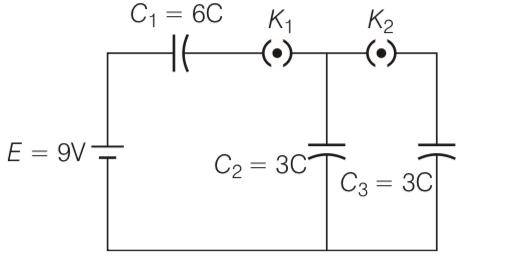
This is a long answer type question as classified in NCERT Exemplar
When initially K1 is closed and K2 is open, the capacitors C1 and C2 connected in series with battery
Q=CV=C (C1C2/C1+C2) = 6 3/6+3=18 C
Now K1 was opened and K2 was closed, the battery and capacitor C, are disconnected from the circuit .
Here charge being shared by both capacitor so a common potential will develop.
V=C1V1+C2V2/C1+C2 = 18/3+3=3V
Q2=3CV=3 3=9μC
Q3=3CV=3 3=9μC
Two charges q1and q2 are placed at (0, 0, d) and (0, 0, -d) respectively. Find the locus of points where the potential is zero.
This is a long answer type question as classified in NCERT Exemplar
Let any three point x,y,z seprated by a distance 2d
Then potential due to two charges
=0
=
X2+Y2+z2+ (2zd)+d2-0
this is equation of sphere .
Calculate potential on the axis of a disc of radius R due to a charge Q uniformly distributed on its surface.
This is a long answer type question as classified in NCERT Exemplar
=charge/Area
Q= (2 )
V=KdQ/ 2+x2)=K (2 )/ 2+x2)

After integration we got
V= 2 ( )-x
Consider two conducting spheres of radii R1and R2 with R1 > R2. If the two are at the same potential, the larger sphere has more charge than the smaller sphere. State whether the charge density of the smaller sphere is more or less than that of the larger one.
This is a short answer type question as classified in NCERT Exemplar
Surface charge density is inversely proportional to radius of the sphere so larger sphere has less charge density and vice versa.
Two point charges of magnitude +q and -q are placed at (-d/2, 0, 0) and (d/2, 2, 0), respectively. Find the equation of the equipotential surface where the potential is zero
This is a long answer type question as classified in NCERT Exemplar
-
If net potential is zero then,
=
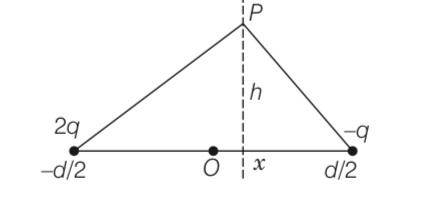
2dx= 0 , x=0
X=0 , y-z plane.
(a) In a quark model of elementary particles, a neutron is made of one up quarks [charge (2/3)e] and two down quarks [charges (-l/3)e]. Assume that they have a triangle configuration with side length of the order of 10-15 Calculate electrostatic potential energy of neutron and compare it with its mass 939 MeV.
(b) Repeat above exercise for a proton which is made of two up and one down quark.
This is a long answer type question as classified in NCERT Exemplar
Potential energy of system of charges be algebraic sum
U =
9 109/10-15 (1.6 -19)2 (1/3)2- (2/3) (1/3)- (2/3) (1/3)
-7.68 10-14J
-7.68 10-14 -19= 0.48Mev
A capacitor is made of two circular plates of radius R each, separated by a , distance d << R. The capacitor is connected to a constant voltage. A thin conducting disc of radius r << R and thickness t << r is placed at the centre of the bottom plate. Find the minimum voltage required to lift the disc if the mass of the disc is m.
This is a long answer type question as classified in NCERT Exemplar
To lift the disc ther must be some electrostatic force is reqired.
F=qE……. (1), E=V/d………. (2)
But the charge required during the process is - 0 r2, using this relation in 1 and 2
F=- 0 r2V/d…… (3)
Also to balance something F=mg……. (4)
From equation 3 and 4
Mg= - 0 r2V/d, so V = 2 this the requird solution.
Find the equation of the equipotential for an infinite cylinder of radius r0 carrying charge of linear density A.
This is a long answer type question as classified in NCERT Exemplar
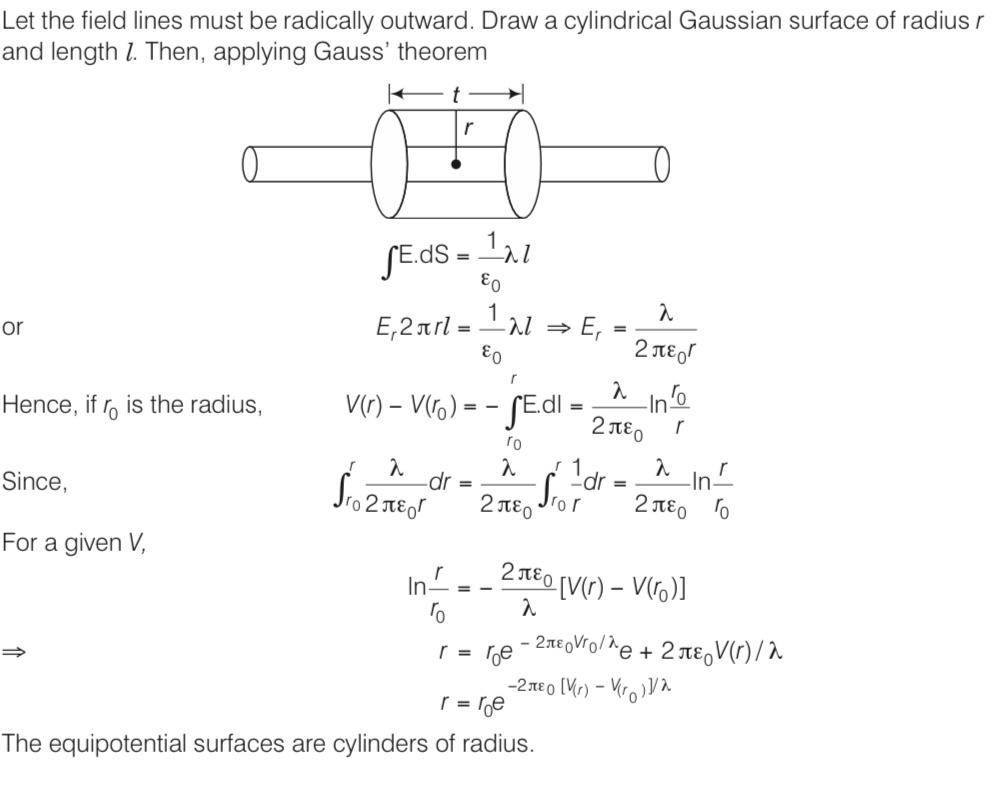
A parallel plate capacitor is filled by a dielectric whose relative permittivity varies with the applied voltage (U) as ε= αU where α = 2V-1. A similar capacitor with no dielectric is charged to U0= 78 V. It is then connected to the uncharged capacitor with the dielectric. Find the final voltage on the capacitors.
This is a long answer type question as classified in NCERT Exemplar
To lift the disc ther must be some electrostatic force is reqired.
F=qE……. (1), E=V/d………. (2)
But the charge required during the process is - 0 r2, using this relation in 1 and 2
F=- 0 r2V/d…… (3)
Also to balance something F=mg……. (4)
From equation 3 and 4
Mg= - 0 r2V/d, so V = 2 this the requird solution.
Prove that, if an insulated, uncharged conductor is placed near a charged conductor and no other conductors are present, the uncharged body must intermediate in potential between that of the charged body and that of infinity.
This is a short answer type question as classified in NCERT Exemplar
According to the relation that E= - , potential always decrease in the direction of electric field . so if we go from any point to infinity that decreases the potential.
The electrostatic potentiaLon the surface of a charged conducting sphere is 100 V. Two statements are made in this regard.
S1 : At any point inside the sphere, electric intensity is zero.
S2: At any point inside the sphere, the electrostatic potential is 100 V.
Which of the following is a correct statement?
(a) S1is true but S2 is false
(b) Both S1 and S2 are false
(c) S1 is true, S2 is also true and S1, is the cause of S2
(d) S2 is true, S2 is also true but the statements are independent
This is a multiple choice answer as classified in NCERT Exemplar
(c) As we know that E= - and potential is always same through out the surface, so according to relation electric field is zero because potential remains same at each point.
Equipotential at a great distance from a collection of charges whose total sum is not zero are approximately
(a) Spheres
(b) Planes
(c) Paraboloids
(d) Ellipsoids
This is a multiple choice answer as classified in NCERT Exemplar
(a) The electric potential due to point charge q is given by V=q/4? 0r
It means electric potential due to point charge is same for all equidistant points. The locus of these equidistant points, which are at same potential, form spherical surface.
Consider a uniform electric field in the z -direction. The potential is a constant
(a) in all space
(b) for any x for a given z
(c) for any y for a given z
(d) on the x-y plane for a given z
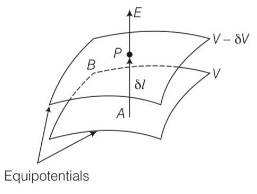
This is a multiple choice answer as classified in NCERT Exemplar
(c) Field lines are always perpendicular to the direction of equipotential surface. The electric field in the in z- direction suggest that equipotential surface are in x-y plane. The shape of equipotential surface depends upon nature and type of distribution of charges.
Equipotential surfaces
(a) are closer in regions of large electric fields compared to regions of lower electric fields
(b) will be more crowded near sharp edges of a conductor
(c) will be more crowded near regions of large charge densities
(d) will always be equally spaced
This is a multiple choice answer as classified in NCERT Exemplar
(a), (b), (c) Properties of equipotential surfaces
In the circuit shown in figure initially key K1is closed and key K2 is open. Then K1 is opened and K2 is closed (order is important). [Take Q’1 and Q’2 as charges on C1 and C2 and V1 and V2 as voltage respectively.] Then, E
(a) Charge on C, gets redistributed such that V1 = V2
(b) Charge on C1 gets redistributed such that Q’1 = Q’2
(c) Charge on C1 gets redistributed such that C1V1 + C2V2 = C1E
(d) Charge on C1 gets redistributed such that Q’1 + Q’2=Q
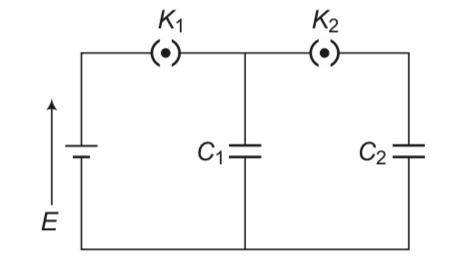
This is a multiple choice answer as classified in NCERT Exemplar
(a), (d) Initially key K1 is closed and key K2 is open, the capacitor C1 is charged by battery and capacitor C2 is still uncharged. Now K1 is opened and K2 is closed, the capacitors C1 and C2 both are connected in parallel. The charge stored by capacitor C1, gets redistributed between C1 and C2 till their potentials become same, i.e., V2 = V1.
By law of conservation of charge, the charge stored in capacitor Cx is equal to sum of charges on capacitors C1 and C2 when K1 is opened and K2 is closed, i.e., Q'1+Q'2=Q
If a conductor has a potential V≠0 and there are no charges anywhere else outside, then
(a) There must be charges on the surface or inside itself
(b) There cannot be any charge in the body of the conductor
(c) There must be charges only on the surface
(d) There must be charges inside the surface
This is a multiple choice answer as classified in NCERT Exemplar
(a, b) The potential of a body is due to charge of the body and due to the charge of surrounding. If there are no charges anywhere else outside, then the potential of the body will be due to its own charge. If there is a cavity inside a conducting body, then charge can be placed inside the body. Hence there must be charges on its surface or inside itself. Also The charge resides on the outer surface of a closed charged conductor. Hence there cannot be any charge in the body of the conductor.
Two metal spheres, one of radius R and the other of radius 2R, both have same surface charge density σ. They are brought in contact and separated. What will be the new surface charge densities on them?
This is a long answer type question as classified in NCERT Exemplar
As we know that, =charge/Area
Q1= (4 2)
Q2= (4 2)= 4Q1
when they come in contact with each other potential being same and charge will be conserved.
So net charge is 5Q1= 5 ( (4 2)
Also V1=V2
KQ1/R=KQ2/2R so Q1=Q2/2
Q1= (4 2) and Q2= (4 2)
=5 /3 and =5 /6
Two charges –q each are separated by distance 2d. A third charge + q is kept at mid point O. Find potential energy of + q as a function of small distance x from O due to – q charges. Sketch P.E. v/s x and convince yourself that the charge at O is in an unstable equilibrium.
This is a long answer type question as classified in NCERT Exemplar
Suppose the charge is slightly shifted to left so net potential energy will be
U=
U=
=
System will be in equilibrium if this energy is zero
But when we double differentiate it

But when x<0 this value is negative so less than 0
This shows an unstable equilibrium
It follows the parabolic graph

Can there be a potential difference between two adjacent conductors carrying the same charge?
This is a short answer type question as classified in NCERT Exemplar
It is only possible when their sizes are different . when their sizes are different there capacity would change. So there is potential difference btween them.
Can the potential function have a maximum or minimum in free space?
This is a short answer type question as classified in NCERT Exemplar
No, the potential function have no free space because when there is a free space there will be a leakage of potential at that point.
A capacitor has some dielectric between its plates and the capacitor is connected to a DC source. The battery is now disconnected and then the dielectric is removed. State whether the capacitance, the energy stored in it, electric field, charge stored and the voltage will increase, decrease or remain constant.
This is a short answer type question as classified in NCERT Exemplar
The capacitance of the parallel plate capacitor, with dielectric medium of dielectric constant K is given by, C=K? 0A/d
The capacitance of the parallel plate capacitor decreases with the removal of dielectric medium.
If we disconnect the battery from capacitor, then the charge stored will remain the same due to conservation of charge.
The energy stored in an isolated charge capacitor U =q2/2C as q is constant, energy stored U ∝ 1/C .As C decreases with the removal of dielectric medium, therefore energy stored increases.
The potential difference across the plates of the capacitor is given by V =q/C
Since q is constant and C decreases which in turn increases V and therefore E increases as E = V/d.
Calculate potential energy of a point charge -q placed along the axis due to a charge +Q uniformly distributed along a ring of radius R. Sketch PE, as a function of axial distance z from the centre of the ring. Looking at graph, can you see what would happen if -q is displaced slightly from the centre of the ring (along the axis)?
This is a short answer type question as classified in NCERT Exemplar
Let us take a point p to be at a distance z from the center of ring
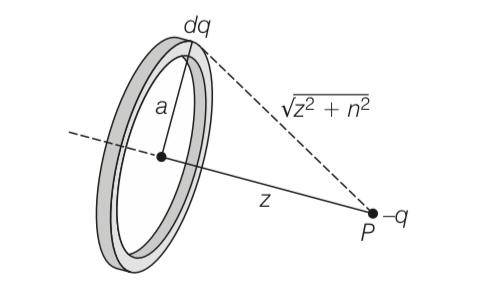
V=K = =
U= w =qV= =
Charge would perform oscillations.
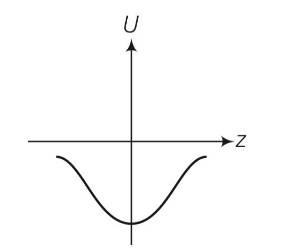
A capacitor of 4 μF is connected as shown in the circuit. The internal resistance of the battery is 0.5 ?. The amount of charge on the capacitor plates will be
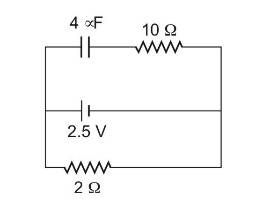
(a) 0
(b) 4 μC
(c) 16 μC
(d) 8 μC
This is a multiple choice answer as classified in NCERT Exemplar
(d) We know that I= = = 1 A
The potential difference across 2 ohm = 1 (2)= 2V
As Q=CV = 4 2= 8 μC
Prove that a closed equipotential surface with no charge within itself must enclose an equipotential volume.
This is a short answer type question as classified in NCERT Exemplar
If there is a potential then E? 0 electric field comes into existence, which is given by as E=-dV/dr
It means there will be field lines pointing inwards or outwards from the surface. These lines cannot be again on the surface, as the surface is equipotential. It is possible only when the other end of the field lines are originated from the charges inside. Hence, the entire volume inside must be equipotential.
A positively charged particle is released from rest in an uniform electric field. The electric potential energy of the charge
(a) Remains a constant because the electric field is uniform
(b) Increases because the charge moves along the electric field
(c) Decreases because the charge moves along the electric field
(d) Decreases because the charge moves opposite to the electric field
This is a multiple choice answer as classified in NCERT Exemplar
(c) Electric potential are always less in the direction of electric field
E= - and W= qdv . so potential energy also decrease in the direction of electric field
Calculate the potential on the axis of a ring due to charge Q uniformly distributed along the ring of radius R.
This is a short answer type question as classified in NCERT Exemplar
Let us take a point p to be at a distance z from the center of ring
V=K = =
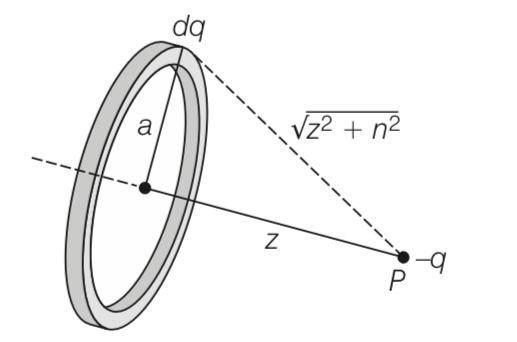
The work done to move a charge along an equipotential from A to B
This is a multiple choice answer as classified in NCERT Exemplar
(b), (c) If potential of two point is same then work done is also zero according to relation As W=qdv=q (final potential-initial potential).
Also W=-qdv= -q
For equipotential surface V2-V2=0 and W=0
Important Formulas Related to Physics Chapter 2 NCERT Exemplar
The following are the important formulas of Chapter 2:
Potential due to a Point Charge
Electric Field and Potential Relation
Potential due to System of Charges
Potential Energy of Two Point Charges
Capacitance of a Conductor
Capacitance of a Parallel Plate Capacitor (Vacuum)
Capacitance with Dielectric
Capacitors in Series
Capacitors in Parallel
Energy Stored in a Capacitor
Energy Density in a Capacitor
Also read:
physics ncert exemplar solutions class 12th chapter two Exam
